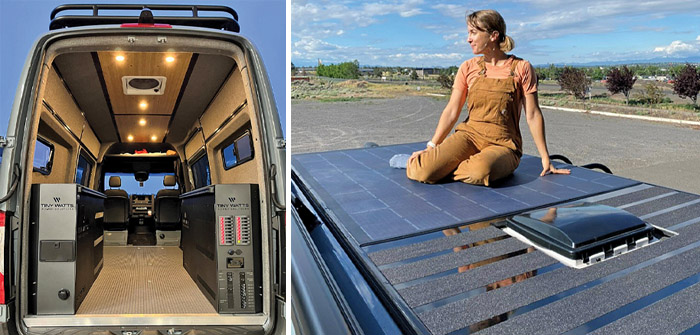((L) Tiny Watts’ 3-in-1 electrical package (water, power, bed platform) in a Sprinter 144 4×4 van. (R) 500W walkable solar roof deck kit | Photos courtesy of Tiny Watts)
In just over a century, the idea of solar power has gone from science fiction to a very accessible reality. According to the Solar Energy Industries Association, in 2021, a new solar system was installed somewhere in the US every 60 seconds, and the value of the solar market that year totaled to $33 billion. As of 2022, there were over 231,000 people employed through the solar industry across the US. When looking at what percent of each state’s electricity comes from solar power, Oregon ranks middle of the pack at #21, with 1.7 percent of our power coming from solar. For comparison, California ranks #1 at 22.2 percent, while both North and South Dakota tie for last place with 0 percent.
Without a doubt, the solar industry is on the rise. This point is echoed by some of the local solar power providers here in Central Oregon. Paul Israel, president of Sunlight Solar, said that business has been steady with sales increasing every year, causing stable growth for his company. Mike Hewitt, vice president of E2 Solar, shared the same sentiment, stating that growth has been steady, while Wes Watts and Savana Watts, the co-owning, co-founding team behind Tiny Watts, said that the last two years have been their best ever.
With an industry growing like this one, it only makes sense that burgeoning new technologies can emerge and change the entire face of the industry. However, technological advancement in this area has been much more steady, and gradual. For solar panels, this typically means that new panels coming out each year are more efficient by about a half of a percent, according to Israel. “The panels we have today are typically higher wattage and smaller in size,” Israel said.
However, Israel followed that statement by saying “a watt is a watt,” indicating that while older solar panels might not be as efficient as newer ones, they still work perfectly fine. He stated that unless a customer with older solar panels has a very small roof and they would like to maximize their solar power, then replacing older panels with newer ones is not very necessary.
“Whether that watt comes from two square feet or one square foot, you’re still getting the energy. Even the older solar panels are great, and there’s really no reason to take panels down unless you’re re-roofing or completely replacing them. For constrained roofs, these new systems can provide more watts for smaller surface area, but in most cases, why take something down that works fine?” Israel said.
A trend echoed across the industry is the increase in use of energy storage systems, or batteries, for residential solar systems. According to Hewitt, “The biggest change has to be energy storage,” he said. “For 20 or so years, having solar did not mean you had backup power. The grid-tied systems didn’t have that component. Now, new energy storage systems allow backup power.”
The desire to have backup power has also been seen by Israel, who said that many of his new residential projects include home energy storage systems. Even at Tiny Watts, a company that primarily focuses on solar power systems for adventure vans, RVs and other mobile projects, the desire to have a backup plan if your house loses power seems obvious.
“We have a client who lost power at their home for 20 hours, and they used their van with our solar power system to plug in, run their fridge, and keep their food from spoiling,” Savana said. “Energy storage is the big thing.”
Another trend that Israel mentioned is the somewhat new desire and capability for home owners to have electric vehicle charging capabilities installed in their home solar systems. “Many older customers are adding elective vehicle charging to their systems,” He said. “People projected that this would happen twenty years ago for a number of reasons. Now, we’re at the point where solar panels are efficient enough where customers can produce and cover their own travel expenses.”
Israel also said that many customers don’t seem to be motivated by the investment side of solar, and instead just want to get away from gas, “It’s been a bit of a social trend to get off of gas,” he said. “People aren’t really looking too much at the investment, they just want their fuel to come from their roof. A lot of people feel guilty going to the gas station, and solar is a fine replacement, when it comes to electric vehicles.”
Hewitt brought up electric vehicles as well, and said, “The biggest thing we’ll see in coming years is electric vehicle integration in the home. Solar power is now intertwined with energy storage and electric vehicles, and people seem to be really excited about it all combining.”
However, Hewitt also says this trifecta of solar power, energy storage and electric vehicle integration will likely stay on the luxury side of solar, for now. “Solar itself without energy storage has become much more accessible,” he said. “Start integrating energy storage and electric vehicles, and the cost goes up.”
Hewitt adds that we are on the trend towards more people having access to solar power, “18-20 years ago, most of the services were for the well off,” he said. “Now, not so much. We are closing the gap between solar haves and have nots.”
This is largely due to federal incentives, like the Federal Residential Solar Energy Credit.
“It’s basically a tax credit for solar energy investments on houses, and it applies to RVs and our camper vans because they Count as second residence,” Wes said. “Customers are investing in renewables, and they are able to get a federal energy tax credit at the end of the year for up to 30% of the total cost. That’s a pretty significant amount.”
Another incentive comes from the Oregon Department of Energy. According to ODOE, “Oregon homeowners can receive a rebate of up to $5,000 for a solar electric system and up to $2,500 for an energy storage system.”
This rebate is distributed differently for households of varying income levels, and whether or not the homeowner is eligible to receive an electric utility incentive. Low-income households can earn $1.80 per watt (DC) of installed capacity, up to 60% of the net cost or $5,000, whichever is less. The net cost is defined as, “the total of all eligible costs minus any incentive provided by an electric utility or by Energy Trust of Oregon.”
While solar power might still seem like a luxury to many people, the current trend in the industry is to make it more accessible.





